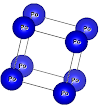Abstract:
This paper is a continuation of our detailed study [Phys. Rev. B 86, 195106 (2012)] of the performance of the recently proposed modified Becke-Johnson potential (mBJLDA) within the known Wien2k code. From the 41 semiconductors that we have considered in our previous paper to compute the band gap value, we selected 27 for which we found low temperature experimental data in order to pinpoint the relative situation of the newly proposed Wien2k(mBJLDA) method as compared to other methods in the literature. We found that the GWA gives the most accurate predictions. The Wien2k (mBJLDA) code is slightly less precise, in general. The Hybrid functionals are less accurate, on the overall. The GWA is definitely the most precise existing method nowadays. In 88% of the semiconductors considered the error was less than 10%. Both, the GWA and the mBJLDA potential, reproduce the band gap of 15 of the 27 semiconductors considered with a 5% error or less. An extra factor to be taken into account is the computational cost. If one would seek for precision without taking this factor into account, the GWA is the method to use. If one would prefer to sacrifice a little the precision obtained against the savings in computational cost, the empirical mBJLDA potential seems to be the appropriate method. We include a graph that compares directly the performance of the best three methods, according to our analysis, for each of the 27 semiconductors studied. The situation is encouraging but the problem is not yet a closed issue
To download the article click on the link below:









0 Comments